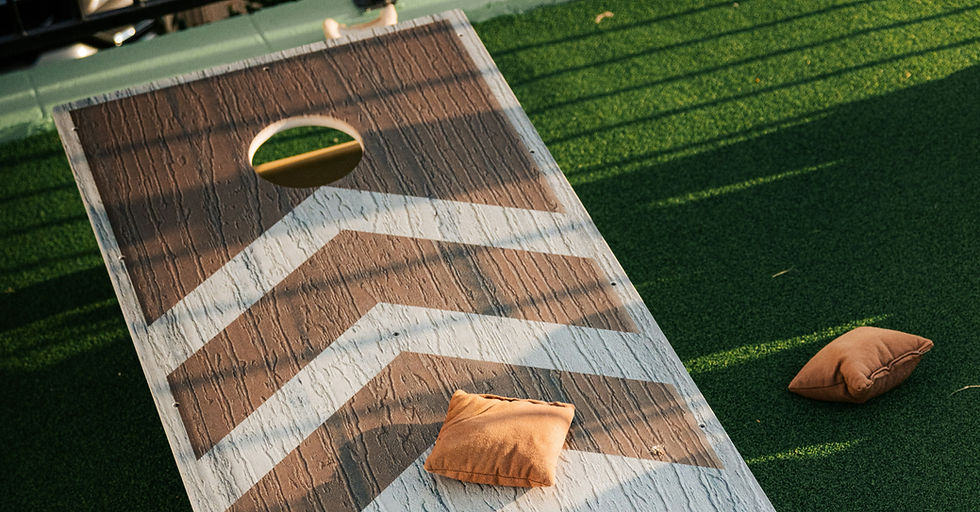Cornhole Board Specs 🎯 – Official Measurements Every DIYer Needs
- Riley Thorne

- Sep 12
- 3 min read
Updated: Sep 13
Cornhole isn’t just a backyard pastime; it’s a competitive game with strict cornhole board specs that must be followed if you want fair play. Whether you’re building your own set or buying one, knowing the official cornhole board measurements and the correct cornhole board hole size is essential.
Following official specs ensures your cornhole boards meet competition standards and make your backyard games more fun and consistent.
This guide covers the exact board dimensions, materials, setup rules, and pro tips for durability.

Why Cornhole Board Specs Matter
Many homeowners make the mistake of building boards “close enough,” only to find out their bags bounce differently or the hole is off-center. Official specs guarantee:
Consistent bag play (no unfair slides or rebounds).
Tournament readiness if you ever join leagues.
Easier replacement if you need new boards.
Official Cornhole Board Specs (ACO & ACL Standard)
Here’s the breakdown of official cornhole board measurements approved by major leagues:
Spec | Measurement | Notes |
Board Length | 48 inches (4 ft) | Regulation size |
Board Width | 24 inches (2 ft) | Regulation size |
Front Height | 3–4 inches | Creates the slope |
Back Height | 12 inches | Regulation height |
Playing Surface Thickness | ½ inch plywood | Smooth, no warping |
Cornhole Board Hole Size | 6 inches diameter | Centered |
Hole Center Placement | 9 inches from top edge, 12 inches from each side | Regulation placement |
Pro Tip: Always sand the surface and coat with polyurethane. This makes bag slides smoother and prevents splinters.
Materials for Building Cornhole Boards
While specs are about size, materials matter too:
Plywood (½ inch) – official surface material.
2x4s – framing support.
Paint or stain – protects wood outdoors.
Polyurethane – for slick, tournament feel.
Setup and Spacing Rules
Building the boards is step one — but setting them up correctly is just as important.
Distance between boards: 27 feet front to front (regulation).
Foul line: front edge of the board.
Bag weight: 14–16 oz (6"x6" bags).
Board angle: naturally created by 12-inch back height.
Cornhole Board Hole Size Explained
One of the most common mistakes DIYers make is cutting the hole wrong. The cornhole board hole size must be 6 inches in diameter. Anything smaller makes it too hard, larger makes it too easy.
Always use a circle guide and jigsaw for accuracy. Sand the edges smooth so bags don’t snag.
Common Mistakes to Avoid
Using particle board (warps with moisture).
Incorrect back height (changes bag drop).
Forgetting to seal edges.
Improper hole placement.
If your cornhole boards aren’t to spec, the game will feel completely different, just like misaligned doors or windows throw off a remodel.
Conclusion – Cornhole Board Specs
The cornhole board specs are simple but strict: 48"x24" board, 12" back height, and a 6" centered hole. By sticking to the official cornhole board measurements and correct cornhole board hole size, you’ll have boards that are fair, durable, and tournament-ready. Build smart, play fair, and your boards will last for years. 🎉
FAQ
What are the official cornhole board measurements? 48" long, 24" wide, 12" back height, 3–4" front height, and ½" plywood surface.
What is the cornhole board hole size? 6 inches in diameter, centered 9" from the top and 12" from each side.
Can I make boards smaller for kids? Yes, many families build 36"x18" boards for children.
Do I need to seal the wood? Yes, polyurethane or exterior paint protects against moisture and makes bags slide properly.
What happens if my board isn’t regulation size? It’s fine for casual play, but gameplay won’t feel like official cornhole.



Comments